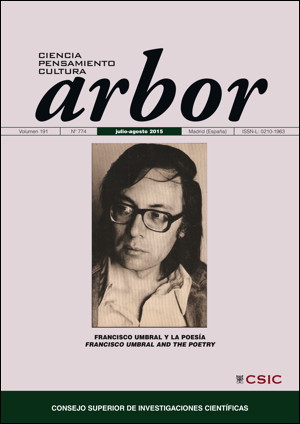Defence of the local thing in José Martí’s Nuestra América and Coney Island: the essay as a space for ideology in hispano-american roots
DOI:
https://doi.org/10.3989/arbor.2015.774n4009Keywords:
American peoples, barbarism, civilization, foreign, discourse strategiesAbstract
José Martí proposes that for the proper development of the Republic in America it is essential to secure a government that has as the premises of its administration the natural categories of its origin. To evaluate the local characteristics Martí was thinking of I will carry out an analysis of two of his essays: Nuestra América (Martí, 1977) and Coney Island (Martí, 1881), in an attempt to unravel the polarisation strategy which supports his argument. Indeed, through a semantic axis the author places the concepts of nature and interiority over external and foreign, making a parallel between what he calls “natural men in America” and those who represent the “other”, the people of the United States. In this way, it will be possible to see how Martí will question the alleged hegemony of the northern country, claiming the primitive qualities of American indigenous peoples, to condition the problem of allocation of barbarism. The main theoretical framework to address this work is the use of the theories of discourse analysis of Teun van Dijk, which will serve me to develop and analyse the semantic axis that Martí creates in the works studied.
Downloads
References
Coronil, F. (1996). Beyond Occidentalism: Toward Post-Imperial Geocultural Categories. Cultural Anthropology, 11, pp. 51-87. http://dx.doi.org/10.1525/can.1996.11.1.02a00030
Fernández Retamar, R. (1997). José Martí en los orígenes del antimperialismo latinoamericano. En Foster, D. W. y Altamiranda, D. Spanish American Literature: From Romanticism to ‘Modernismo’ in Latin America. New York y Londres: Garland: pp. 247–255.
Giannini, H. (2006). Breve Historia de la Filosofía. Santiago de Chile: Catalonia.
Hodelín, R. Enfermedades de José Martí. Recuperado de: http://files.sld.cu/boletincnscs/files/2009/03/resumen-hodelin.pdf
Leante, C. (1990). Martí y el destierro. Revista Iberoamericana, 152-153, pp. 823-827. http://dx.doi.org/10.5195/reviberoamer.1990.4788
Marban, J. Evolución y Formas en la Prosa Periodística de José Martí. Recuperado de: http://revista-iberoamericana.pitt.edu/ojs/index.php/Iberoamericana/article/viewFile/4554/4721
Martí, J. (1977). Nuestra América. Caracas: Fundación Biblioteca Ayacucho.
Martí, J. (1881). Coney Island. Recuperado de: http://www.wwnorton.com/college/english/latino-literature/pdfs/2_Annexations/Marti_Coney.pdf.
Martí, J. (1882). Prólogo al Poema Al Niágara. Recuperado de: http://www.josemarti. info/libro/prologo_poema_niagara.html
Martí, J. (1887). El Poeta Walt Whitman. En Obras Completas. La Habana: Nacional de Cuba.
Mignolo, W. (1998). Postoccidentalismo: el Argumento desde América Latina. Recuperado de: http://www.ensayistas.org/critica/teoria/castro/mignolo.htm
Omaña, B. (1989). Concepción de la poesía en José Martí. Revista Iberoamericana, 146-147, pp. 193–209.
Ossandon, B. (1980). ’Nuestra América’ de José Martí. Recuperado de: http://www.blest.eu/cultura/ossandon.html
Ramos, J. Tres Artículos Desconocidos de José Martí. Recuperado de: http://revista-iberoamericana.pitt.edu/ojs/index.php/Iberoamericana/article/view/4556/4723
Sal Paz, J. C. y Maldonado, S. (2009). Estrategias discursivas: un abordaje terminológico. Espéculo. Revista de Estudios Literarios, 43.
Schulman, I. (1960). Símbolo y color en la obra de José Martí. Madrid: Gredos.
Spivak, G. (1998). ¿Puede Hablar el Sujeto Subalterno? Recuperado de: http://www.redalyc.org/pdf/1050/105018181010.pdf.
Van Dijk, T. (1980). Las estructuras y funciones del discurso. México: Siglo XXI.
Published
How to Cite
Issue
Section
License
Copyright (c) 2015 Consejo Superior de Investigaciones Científicas (CSIC)

This work is licensed under a Creative Commons Attribution 4.0 International License.
© CSIC. Manuscripts published in both the printed and online versions of this Journal are the property of Consejo Superior de Investigaciones Científicas, and quoting this source is a requirement for any partial or full reproduction.All contents of this electronic edition, except where otherwise noted, are distributed under a “Creative Commons Attribution 4.0 International” (CC BY 4.0) License. You may read here the basic information and the legal text of the license. The indication of the CC BY 4.0 License must be expressly stated in this way when necessary.
Self-archiving in repositories, personal webpages or similar, of any version other than the published by the Editor, is not allowed.














